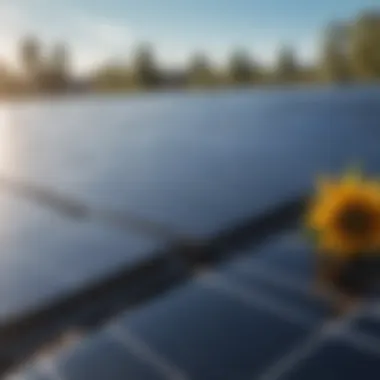Renewable Energy and Environmental Stewardship


Intro
The growing conversation around renewable energy does not merely touch on energy production; it spills into economic growth and environmental preservation. The push toward renewable solutions, such as wind and solar energy, connects innovation with a need for sustainability. As we navigate through this intricate relationship, it becomes essential to recognize how investments can spur advancements in this arena. There’s a lot at stake, and understanding the nuances is critical not just for industries but for the planet itself.
Overview of Investment Products
In the green energy sector, various investment products line up like a buffet, ready for the discerning investor. While traditional options like stocks and bonds are well-known, the renewable energy space presents unique opportunities. Let’s break down some key investment avenues that contribute to environmental stewardship.
Description of Different Financial Products
- Green Stocks
These are shares in companies focused on renewable energy solutions, including firms that manufacture solar panels or develop wind farms. Investing in these stocks supports companies that prioritize environmental sustainability. - Green Bonds
Issued by governments and organizations, these bonds fund projects aimed at sustainability, like building energy-efficient infrastructures or expanding renewable energy resources. They are often tax-exempt, making them attractive. - Exchange-Traded Funds (ETFs)
ETFs that emphasize clean energy allow investors to diversify their holdings among various companies while still focusing on the renewable sector. This helps spread risk, balancing potential rewards as the industry expands. - Mutual Funds
Similar to ETFs, renewable energy mutual funds offer a collection of investments. However, their management styles differ. If a manager is savvy, these funds can lead to significant positive environmental impact alongside financial returns.
Importance of Understanding Investment Options
Investors must grasp these options to make informed choices. Renewable energy investment products not only yield potential monetary returns but also help fund innovations that align with global sustainability goals. A keen understanding can empower investors to play their part in moving toward an eco-friendlier world.
Investment Terminology
With any financial sector, specific terminology can boggle the mind. To navigate this space effectively, here are some critical terms you should know.
Key Terms and Definitions
- Carbon Footprint: Measure of the total greenhouse gases produced directly and indirectly by human activities. In renewable energy discussions, it refers to the reduction of emissions through sustainable practices.
- Sustainable Investing: Investment strategy that takes into account environmental and social factors alongside financial returns. This seeks to create positive impact.
- Renewable Energy Certificates (RECs): Certificates that represent proof that energy has been generated from renewable resources. These can add investment value while promoting green practices.
Common Terminology Misconceptions
One mistake many make is conflating renewable energy with the broader notion of "green" products. While all renewable energy can be green, not all green products are renewable. For example, some biofuels are derived from non-sustainable sources. Being precise about terms helps in fostering a clearer understanding of the industry landscape.
"Investment in renewable energy is not merely a financial decision; it's a step towards preserving the earth for future generations."
As we continue exploring the ties between renewable energy and environmental stewardship, we must keep the focus squarely on how informed investments can foster not just financial growth but also responsible actions towards safeguarding our planet.
Understanding Renewable Energy
Renewable energy is a term that increasingly finds its way into everyday conversations. Its relevance cannot be overstated, considering the pressing need for sustainable solutions to combat climate change. The importance of this section lies in unpacking what renewable energy is, the risks of ignoring it, and how it juxtaposes with environmental stewardship.
The conversation begins with defining renewable energy—sources that are replenished naturally and are less harmful to our planet. Understanding this concept unlocks the door to grasping the broader impacts on environmental health and economic stability.
Also, it sheds light on the advantages this energy source presents. It focuses on sustainability, reduction of greenhouse gases, and the potential for job creation. However, there are considerations such as land use, energy storage, and technological barriers that we must not overlook. The following subsections aim to provide a more detailed exploration of these topics.
Defining Renewable Energy
In simple terms, renewable energy encompasses energy derived from natural resources that can be replenished. Unlike fossil fuels, which may take millions of years to form and can cause severe environmental degradation when extracted, renewable sources such as sunlight, wind, and water continuously regenerate. This ensures a consistent supply that aligns better with the demands of a growing population.
The definition extends beyond mere terminology. It encapsulates a shift in how we perceive energy production and consumption, signaling a collective move towards sustainability.
Types of Renewable Energy Sources
Solar Energy
Solar energy is harnessed from sunlight, potentially the most abundant energy source available. It is characterized by photovoltaic cells and solar thermal systems, converting sunlight into usable electricity. The key characteristic of solar energy is its sheer availability; almost every area on Earth receives solar radiation to some extent. This makes it an appealing choice for households and businesses alike.
A unique feature of solar is its scalability. Homeowners can install small panels, while large-scale solar farms can generate significant energy supplies. However, disadvantages include high initial setup costs and efficiency dependent on weather conditions.
Wind Energy
Wind energy captures energy from moving air through turbines, transforming it into electricity. Its most striking aspect is the minimal environmental footprint it leaves behind during operation. Wind farms can be constructed on land or offshore, allowing for flexibility in placement.
The beneficial aspect of wind energy is its potential for low operating costs once established. Yet, critics often point to disadvantages, such as noise concerns and impacts on wildlife, particularly birds.
Hydropower


Hydropower utilizes flowing water to produce electricity, most commonly harnessed from rivers or dams. It stands out due to its high efficiency and reliability as a power source. The key characteristic of hydropower is its ability to provide consistent energy, making it a backbone for many regions’ energy needs.
However, the unique feature of hydropower is its dual role in water management, such as flood control and irrigation support. Yet, large dams can disrupt local ecosystems and communities, presenting significant disadvantages that must be addressed.
Geothermal Energy
Geothermal energy taps into the heat stored beneath the Earth's surface. This method generates power with relatively low emissions compared to fossil fuels. The key characteristic is its reliability, providing a constant energy source regardless of weather or time of day.
Its advantage lies in its minimal land footprint and sustainable nature, but it may not be suitable in all locations, as it requires specific geological conditions. Potential disadvantages include high initial costs and the risk of induced seismicity.
Biomass Energy
Biomass energy is derived from organic materials like plant matter and animal waste. This source of energy is somewhat unique because it can convert waste into fuel, promoting a circular economy. The key characteristic is this recycling aspect, making it a sustainable choice.
Furthermore, advantages include the reduction of waste and lower carbon emissions compared to fossil fuels. However, the disadvantage lies in land use competition; growing crops for energy can impact food supply and lead to deforestation.
Current Trends in the Renewable Energy Sector
The renewable energy sector is abuzz with innovation and progress. Key trends shaping the landscape include the following:
- Increased investment in technology: More players are entering the game, focusing on improving efficiency and reducing costs.
- Policy adjustments and regulations: Countries are revising their frameworks to support a cleaner energy future.
- Collaboration between private and public sectors: Alliances are forming to push the boundaries of what's possible.
As we consider these elements, it’s clear the renewable energy sector is not just a fleeting trend; it's a vital piece of our future and integral to advancing environmental stewardship.
"To achieve sustainability, we must move beyond traditional energy paradigms and embrace renewable solutions as a cornerstone of our ecological mission."
The Environmental Impact of Renewable Energy
The discussion around renewable energy cannot simply be a matter of technological advancement or economic gain; it needs to tie back to those core ideals of environmental stewardship. As we plunge headfirst into this era of energy transition, understanding the environmental impact of renewable energy sources becomes crucial. Renewable energy is often hailed as a solution to combat climate change and reduce pollution, but it comes with its own set of challenges and considerations. Examining these elements helps clarify how the move to greener energy not only benefits the planet but also demands responsible management of ecosystems, land, and biodiversity.
Addressing Carbon Footprint
When we talk about reducing our carbon footprint, renewable energy stands as a shining example. Unlike fossil fuels, which belch out greenhouse gases into the atmosphere, solar panels and wind turbines produce clean energy with minimal emissions. For instance, you may have heard about how a typical coal-fired power plant emits roughly 2.2 pounds of CO2 for every kilowatt-hour it generates. In contrast, harnessing solar power can substantially lower these emissions.
However, while the operations of renewable energy sources are much cleaner, we shouldn’t ignore the total lifecycle assessment. Let's break it down:
- Manufacturing of solar panels or wind turbines can be energy-intensive, particularly if reliant on non-renewable materials.
- Transportation of these massive components adds to the carbon output, especially when imported from far-off lands.
- Disposal of equipment at the end of their life—if not managed properly—can contribute to landfill waste.
It's a fine balancing act; while renewable energy vastly reduces emissions during generation, we still have to be mindful of the full scope of their environmental costs. Educating stakeholders on these aspects can lead to innovations in recycling and better manufacturing processes.
Land Use Considerations
Land use is a double-edged sword in the conversation about renewable energy. On one hand, vast solar farms and wind farms can disrupt existing ecosystems, leading to habitat fragmentation and changes in local biodiversity. For example, large scale solar installations on previously undisturbed land can displace native flora and fauna, creating an imbalance in the ecosystem. There’s a real risk that the rush to build these clean energy sites can override thoughtful land management.
On the other hand, these considerations offer an opportunity for innovative solutions. Vertical solar panels and urban wind turbines can integrate renewables into built environments without consuming additional land. Plus, permits that require land restoration and biodiversity conservation as a precondition for site approval are steps in the right direction.
To summarize the impact of land use:
- Positive: Decrease in certain pollutants and habitat restoration initiatives.
- Negative: Habitat disruption and changes to the landscape, which can take decades or centuries to revert.
Biodiversity and Ecosystem Preservation
Renewable energy projects come with a responsibility—one that calls for preserving biodiversity and ecosystems. Wind farms, for example, face scrutiny due to their potential effects on bird and bat populations. The placement of turbines must be carefully evaluated to avoid migratory routes and nesting sites.
Yet, when planned correctly, renewable energy can enhance biodiversity. Land used for solar farms can be designed to promote native grasses or wildflowers, transforming these spaces into habitats, rather than barren fields. A practical example can be seen in agrivoltaics, where farming and solar energy production co-exist. Crops can thrive in partial shade under solar panels while simultaneously producing clean energy.
One effective strategy for minimizing impacts is implementing environmental impact assessments (EIA). These assessments should not only highlight potential risks but also outline plans for mitigation. Key aspects include:
- Preserving Habitats: Identifying and protecting key wildlife habitats.
- Monitoring Bird Populations: Using technology to monitor bird movements and mitigate risks like collisions with turbines.
- Educating Communities: Engaging local populations about preserving biodiversity while embracing renewable energy.
Economic Implications of Renewable Energy
The adoption of renewable energy sources goes far beyond just benefiting the environment; it also has significant economic implications. Understanding this intersection can provide insights into how green energy solutions contribute to job creation, pricing dynamics, and overall market trends. As both individuals and companies shift their focus towards sustainable practices, the potential for economic growth in the renewable energy sector becomes a crucial consideration.


Job Creation in the Renewable Sector
One of the most promising aspects of the renewable energy transition is its substantial impact on job creation. As new technologies and projects emerge, a multitude of positions arise across the industry. Research from the International Renewable Energy Agency (IRENA) highlighted that global employment in renewables has already reached millions.
Some key areas of job growth include:
- Manufacturing roles for solar panels and wind turbines.
- Installation technicians who specialize in solar, wind, and geothermal systems.
- Maintenance and operations roles ensuring optimal functionality of renewable energy systems.
- Research and development, driving innovation to improve efficiency and reduce costs.
This breadth of opportunities not only stimulates local economies but also contributes to regional development, particularly in areas that were previously reliant on fossil fuels. The challenge remains to provide adequate training and education to prepare workers for these new roles, so that they can successfully transition to a greener economy.
Impact on Energy Prices
The market for energy has seen a seismic shift due to the growing presence of renewable resources. As more stakeholders invest in solar and wind, the increased competition fundamentally alters energy pricing. While traditional energy markets have been historically dominated by a few major players, renewables tend to favor decentralization, which disperses market power.
The implications include:
- Lower energy costs for consumers, as resources become abundant, making it cheaper to harness energy from wind, sun, and other sources.
- Increased price stability, mitigating the historical volatility associated with fossil fuel markets due to geopolitical tensions.
- Long-term savings, as investments in renewables contribute to decreasing operational costs over time, reducing reliance on imported fuels.
This shift is crucial, particularly for low- and middle-income households that tend to be most vulnerable to energy price hikes. The more we embrace renewable solutions, the less exposed we become to price fluctuations, fostering more sustainable economic environments.
Investment Trends and Innovations
As the world pivots towards sustainable energy, investment trends are evolving drastically. Over recent years, capital flows into the renewable sector have surged, attracting venture capital, government financing, and large institutional investors. This influx of funds facilitates a range of revolutionary innovations, including:
- Energy storage solutions, which aim to overcome the intermittency challenges found in solar and wind technologies.
- Advanced grid integration technologies that enhance the efficiency of energy distribution.
- Development of smart grid infrastructures, which utilize data analytics to optimize energy consumption and generation.
Moreover, the influence of technology in facilitating investor engagement cannot be overlooked. Platforms that aggregate data on a company’s sustainability efforts are increasingly sought after. These innovations not only promise potential financial returns but also allow investors to park their money in projects aligned with their values and that encourage responsible environmental practices.
Investing in renewable energy is not just a financial decision; it's an investment in the planet's future sustainability.
Regulatory Frameworks and Policies
In the nexus of renewable energy and environmental stewardship, regulatory frameworks and policies play a pivotal role. These regulations govern how renewable energy is developed, integrated, and incentivized within markets. Their purpose extends beyond mere compliance; they aim to create an ecosystem where sustainable practices flourish. The frameworks dictate everything from tax breaks for solar installations to stringent standards ensuring environmental protection during energy production.
The real beauty of these policies lies in their ability to harmonize economic growth with ecological sustainability. By establishing clear guidelines, they pave the way for investments in clean energy technology, which can lead to job creation and innovation. Last but not least, effective policies can bring about marked reductions in greenhouse gas emissions, making it easier for nations to achieve their climate goals.
Government Incentives and Support
Government incentives are the linchpin in the transitional journey toward green energy. These incentives often take the form of tax credits, grants, or subsidies. The federal solar investment tax credit, for instance, has been instrumental in making solar panels more accessible to average homeowners. This appeal doesn’t just stop with individuals, though; businesses also benefit. Many companies are investing heavily in renewable energy systems, encouraged by such incentives, which can significantly lower their operational costs.
In addition to financial support, educational initiatives are vital. Programs designed to inform the public about renewable energy benefits can foster greater acceptance. When people know how much they can save or how their actions impact the environment, they’re more likely to take a leap toward sustainability.
International Agreements and Protocols
International collaboration is paramount for combating climate change, and this often finds its voice in agreements and protocols. Treaties like the Paris Agreement serve as binding contracts for countries to meet specific emissions reductions over time. Such commitments provide a frame of reference for national policies and encourage transparency in reporting progress.
Moreover, international frameworks can spur innovation by creating a competitive environment. When countries know they are held accountable globally, they work towards clean technology advancements as a matter of course. This international push magnifies efforts on a national level, leading to comprehensive policies that can filter down to community projects.
"Without the frameworks set up by international bodies, our local efforts might dwindle into mere good intentions."
Local and Regional Policy Implementation
While international agreements offer a macro view, local and regional policies are where initiatives truly take shape. Local governments are uniquely positioned to address community-specific concerns, enabling tailored solutions. For example, a coastal city might prioritize wind energy, while a sun-drenched desert community could focus on solar. Regional policies can also encourage the development of microgrid systems, promoting energy independence and resilience against power outages.
Engaging local stakeholders, from residents to business owners, is essential in this regard. Local policy implementation often faces hurdles like zoning laws and community opposition. However, with effective communication and participation, these policies can gain traction. Both user-generated feedback and community forums help pinpoint the best approaches to energy solutions while ensuring transparency.
In summary, regulatory frameworks and policies act as fundamental building blocks in the transition to renewable energy. They not only facilitate immediate benefits but also create a stable environment for long-term sustainability goals.
Challenges in the Renewable Energy Transition
In the quest for a more sustainable future, transitioning to renewable energy sources brings along a myriad of challenges that must be navigated. This journey isn’t just about installing solar panels or erecting wind turbines; it's a complex interplay of technology, society, and economics. Understanding these challenges is crucial for policymakers, investors, and the general public as they collectively seek to enhance environmental stewardship and promote a greener economy.


Technological Barriers
Technology is the backbone of the renewable energy sector, yet it doesn’t come without its quirks and hurdles. One prominent issue is the storage of energy. Unlike fossil fuels, renewable sources like solar and wind are intermittent. This means that energy production can fluctuate wildly based on environmental conditions, making it a challenge to maintain a steady supply. To counter this, we've seen various battery technologies emerge, like lithium-ion and flow batteries, but they often face limitations in capacity and cost. The push for innovative storage solutions is critical; otherwise, communities could find themselves in a pickle, relying on backup fossil-fuel-generated electricity.
Furthermore, grid infrastructure often lags behind the adoption of renewables. Many power grids are outdated and ill-equipped to handle the decentralized generation that solar and wind energy require. This disconnect can lead to inefficiencies and increased costs. Therefore, investing in smart grid technologies is essential. This means better managing energy flow and integrating varied energy sources effectively.
Public Acceptance and Awareness
Public perception plays a pivotal role in the renewable energy transition. While many are champions for clean energy, others may shy away, driven by misconceptions or a lack of information. For instance, the sight of wind farms might be off-putting to some, who feel it disrupts the beauty of their landscape. Similarly, fears about noise pollution or health concerns related to wind turbines can lead to local opposition.
Awareness campaigns are invaluable here. The importance of renewable energy needs to be communicated clearly. People need to understand not just the benefits, but also the technical aspects and safety measures in place. Engaging communities through educational initiatives can help mitigate fears and skepticism. Creating a bridge between technicalities and everyday understanding will empower local populations to embrace renewable solutions wholeheartedly.
Funding and Investment Hurdles
Money makes the world go around, and this adage holds true for the renewable energy industry as well. Despite the potential for growth, securing sufficient funding remains a significant obstacle. Investors often hesitate, viewing renewable projects through a lens of risk and uncertainty. Factors like variable returns and long payback periods can scare off even the most ardent investors.
To tackle these fears, clarity is needed in the financial models that accompany renewable projects. Governments and organizations could consider offering guarantees or incentives to create a more appealing investment climate. Additionally, crowdfunding and community-funded solar projects can engage local investors while easing the burden of traditional financing.
As countries and societies continue toward greener energy solutions, recognizing and jumping over these barriers becomes mandatory. Without addressing technological challenges, enhancing public knowledge, and stabilizing funding avenues, the path to renewable energy may become a rocky road to traverse.
Future Trends in Renewable Energy and Environment
The landscape of renewable energy is shifting rapidly, an evolution fueled by emerging technologies, increased public awareness, and an urgent need for sustainable practices. Understanding the future trends in renewable energy not only illuminates the path toward cleaner energy but also reveals the intricate ties this field has with broader environmental stewardship. With the sun shining brightly on potential advancements and innovations, the benefits of these trends can be far-reaching—impacting economies, ecosystems, and everyday lives. Here’s a closer look at what’s on the horizon.
Emerging Technologies
Innovative technologies are the beating heart of renewal energy prospects. Solutions such as improved solar panels and advanced wind turbines are not just enhancements; they redefine the boundaries of efficiency.
For example, the development of perovskite solar cells stands out. These cells promise greater efficiency at lower costs, offering a game-changing potential in energy generation. As researchers dabble with various materials, the aim is to create panels that are lighter, cheaper, and more efficient than their silicon counterparts. Just imagine a world where rooftops potentially become mini-power plants.
Emerging battery technologies are equally compelling. The rise of solid-state batteries could significantly increase the storage capacity of energy harvested from renewable sources, making it a robust alternative in the grid. As we look into these technologies, it’s clear that they’re not only about power; they’re about empowerment.
Decentralized Energy Solutions
The concept of decentralized energy solutions is gaining traction as communities seek to bolster sustainability while reducing dependence on traditional energy grids. Solar panels on homes or community energy projects are pivotal examples. Here, energy is generated close to where it’s consumed, minimizing transmission losses and batch discharging costs.
The spread of microgrids is a classic case of this trend. These localized networks can operate independently or in conjunction with the main grid, granting communities the flexibility to manage their own energy needs efficiently. During a regional outage, for instance, communities using microgrids can maintain power, a stark contrast to the vulnerabilities of larger systems.
Additionally, the rise of peer-to-peer energy trading platforms allows individuals to buy, sell, or trade excess energy generated from their renewable sources. This democratization of energy could transform how we view consumption and production and blur the lines between producer and consumer.
The Role of Artificial Intelligence
Artificial intelligence finds its place at the crossroads of energy efficiency and environmental sustainability. AI has the potential to optimize energy consumption patterns dramatically. By analyzing vast amounts of data, it can predict and manage energy use in real-time, leading to significantly reduced waste.
Smart grids, powered by AI, can anticipate demand fluctuations and adjust accordingly. This means less reliance on backup fossil-fuel power plants during peak times, which is critical in minimizing emissions. Furthermore, AI can also play a role in predicting equipment failures before they happen, aiding in both maintenance and reliability.
"The integration of AI into renewable energy solutions could usher in a new era of efficiency and environmental stewardship."
In summary, the future trends in renewable energy and environment spotlight a promising interplay of technology, community engagement, and data-driven strategies. As we look toward this horizon, it’s clear: these trends do not just reflect energy innovation, they embody a significant step towards a sustainable future that values environmental stewardship as much as energy production.
End
In this article, we have traversed the multifaceted landscape where renewable energy converges harmoniously with environmental stewardship. The essence of this intersection is not merely in harnessing energy from sustainable sources, but in cultivating an ethos of responsibility toward our planet. As we look forward, it is clear that integrating renewable energy practices within broader environmental strategies holds significant benefits for ecosystems, economies, and societies alike.
Summarizing Key Insights
Throughout our exploration, several key insights have emerged regarding renewable energy and its role in fostering environmental preservation:
- Diverse Energy Sources: The mix of renewable sources—solar, wind, hydropower, and more—offers unique solutions tailored to geographic and economic contexts. Each has its advantages and challenges, revealing that no single energy source will provide a panacea to the energy crisis.
- Climate Mitigation: By moving away from fossil fuels, a substantial reduction in greenhouse gas emissions is achievable. This transition is not just an environmental necessity; it’s a strategic economic opportunity that can lead to job creation and sustainable growth.
- Policy and Regulation: Legal frameworks and international agreements are pivotal in steering investments toward renewables. By incentivizing clean energy, governments can help destroy barriers that currently hinder progress.
- Technological Innovations: The rapid development of technologies—such as energy storage, smart grids, and energy-efficient appliances—plays a vital role in enhancing the effectiveness of renewable energy systems and addressing intermittency issues.
These insights underline the importance of continuing dialogues around policy reforms, technological advancements, and public engagement to ensure that renewable energy adoption is both effective and beneficial.
The Path Forward
Looking ahead, the journey toward integrating renewable energy with environmental stewardship will be crucial for shaping a sustainable future. Here are some considerations:
- Collaborative Efforts: Stakeholders, including governments, businesses, and communities, must work together to create an aligned vision. Public-private partnerships can facilitate investments in innovative projects that reflect local needs.
- Education and outreach: Raising awareness about the benefits of renewable energy and environmental stewardship is critical. Education campaigns can empower individuals to take action and support clean energy initiatives.
- Research and Development: Continued investment in R&D will drive technological advancements. As new energy solutions emerge, they can challenge existing paradigms, creating a more flexible energy landscape.
- Global Responsibility: Climate change is a global issue that transcends borders. International cooperation is essential in sharing resources, knowledge, and strategies to ensure equitable access to renewable energy worldwide.
To conclude, the intersection of renewable energy and environmental stewardship is a complex but vital space that offers a path toward a more sustainable society. By addressing the challenges head-on and seizing the opportunities within this domain, we can set our sights on a future where energy production aligns harmoniously with ecological preservation.



